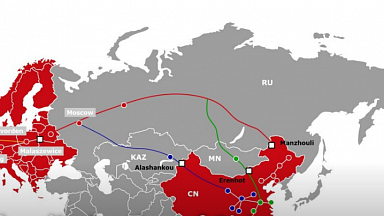Asia-Europe ocean freight rates are continuing to rise amid surging demand, out-of-position vessels and equipment, and congestion issues affecting multiple ports, with China-UK prices regularly now exceeding $10,000 per forty-foot equivalent unit (feu) and rising further by the week. And even the passing of the pre-Christmas stock build-up and a UK-EU trade agreement are unlikely to ease «the perfect storm of deep-sea ocean supply chains», according to some freight and logistics specialists.
Although Shanghai-Europe prices listed on the Shanghai Containerised Freight Index (SCFI) show averages just over $3,100 per twenty-foot equivalent unit (teu) including waterborne surcharges, a rise of around 5% on the previous week, the real cost paid by cargo owners has soared even higher amid further surcharges including congestion and container repositioning charges.
And for the currently troubled UK freight market, which faces higher pricing than mainland European main base ports even in normal times, rates have soared consistently above $10,000 per feu throughout much of December, reaching $10,500 by the middle of December and continuing to rise, with much higher levels also quoted in the market of $12,000 and $13,000 and even higher, freight sources say.
Peter Wilson, group managing director of logistics and maritime service provider Cory Brothers, told Lloyd’s Loading List in an interview published this week that by mid to late November, the company had identified and warned customers that very high rates were coming, «moving to the $7,000-$8,000 mark», making people aware that it would reach $10,000 per 40’ unit.
By 15 December, $10,500 had become the market FAK rate required to get any reliable access to capacity, including the base rate and surcharges. Wilson explained: «Even at $8,000, $9,000, $10,000 a box, we’re still not being guaranteed shipment. They are taking in highest-paying freight only.»
And even $10,500 won’t get you guaranteed space — «not if someone is prepared to pay more».
Wilson said he can understand rate increases that may be put in place to «try and mitigate issues, so that people won’t book», but that’s not the case currently. «The issue is, there’s this huge demand, people are paying, but that’s directly affecting unit price for end consumers, or stuff won’t ship,» he noted.
And those figures are rising further almost by the day, due to higher base rates or surcharges.
Peak-season surcharges
«The UK in particular hasn’t seen peak-season surcharges for about seven years,» highlighted Wilson. «And these surcharges are worth $1,500 a teu to $2,500 for a 40 foot. And they’re increasing along with the base rates.»
He continued: «There are some lower level rates available in Europe to get into Rotterdam or into other ports, but the average is quite considerable.»
The additional charges for shipping cargo to the UK compared with base European main port rates fluctuates, but indicators suggest a difference of around $2,000 to $2,500 between rates to Rotterdam and UK ports.
Normally Cory would not normally be bringing UK containers into Rotterdam. «But a number of lines are saying that they’re not prepared to quote to UK and will only go into northwest Europe. And obviously, then there’s the potential cost implication of feedering those boxes into the UK,» Wilson highlighted.
And those feeder services «are absolutely full; they are at capacity, if you look at ports like Thamesport, Grimsby, Liverpool». And some Asia-UK services are even being routed to Liverpool. «Liverpool for the China routes is unheard of,» noted Wilson.
Insufficient port capacity
«All of this UK container port capacity is not enough to deal with what we’re facing right now. There is a not enough capacity in any of the ports — deep sea or short sea — to deal with the demand.»
All of these factors are not just causing delays and disruption but are also contributing to the huge rises in ocean freight costs, which have risen more than fourfold in less than three months to levels well beyond the high levels listed in indices such as the SCFI.
Taking the SCFI base freight rates as a guide for Shanghai-Rotterdam prices, that might give a Shanghai-Rotterdam average price of $6,200 per feu plus around $2,500 for the UK premium, taking prices to around $8,600 per feu. But UK freight forwarding sources said «the carriers are loading the overall costs with various surcharges» including UK Surcharge (UKS), Peak Season Surcharge (PSS), Equipment Imbalance Surcharge (EIS), along with «feeder costs to the UK, as more calls are going into northwest European ports, etc.».
Although these FAK (freight of all kinds) spot rates only form part of the ocean freight market, the availability of long-term contract rates has also been slashed in recent months.
Named accounts slashed
«You’ve also got named accounts, but capacity on named accounts has been really chopped,» Wilson noted. «We’ve seen 50%, 60% of our named account capacity being trimmed. Others have said 70% of their named account capacity being trimmed down and absolute minimums on named accounts.
«And the BCOs are obviously working at BCO rates now; but with all the additional surcharges, you’re looking at, maybe a $3,000-3,500 increase on top of the base kind of BCO rates that were there. So, they’re not paying $10,000, but they’re probably still paying $4,500-5,000.»
These BCO rates are the «base cargo» that lines offer to customers making large numbers of movements a year of perhaps 10,000 to 30,000 teu — chiefly the big supermarket chains. These base cargo rates act as the base for the market for the rest of the year, running from January to December.
«They’re in negotiation now for 2021,» says Wilson. Although some indicators suggest that BCO rate may be around $2,500 as a base rate in 2021, Wilson suspects «it may well possibly be higher. But that will set the standard — plus surcharges — across the market for the next twelve months at least.»
Mike Bowden, group marketing and procurement manager for Cory Brothers, does not expect any imminent easing in either pricing or market conditions, despite the passing of the Christmas holiday period, even with a UK-EU trade agreement. In fact, the challenges in recent days of lorry backlogs to the UK channel port of Dover have only added to the complications.
«The perfect storm of deep-sea ocean supply chains and now the early EU issues will only worsen in the coming weeks,» he said.
These observations and expectations are consistent with those of other forwarders. In its latest market update this week, US freight forwarder Flexport noted that container lines had implemented further general rate increases (GRIs) on Asia-Europe services from 15 December, with a further increase expected to be implemented from 1 January. And on the capacity side, it recommended advance booking notice of at least 21 days prior to the cargo ready date (CRD) for Asia-Europe cargo.
Flexport added: «Rates have increased significantly during December and will continue to do so in January in the lead up to CNY (Chinese New Year). There will be severe equipment shortages through CNY and equipment substitution is advised where relevant. Urgent shipments should be booked on premium directly, as even premium offerings have become more limited.
«There are widespread restrictions for UK cargo due to port congestion and haulage limitations and there will be further delays and port omissions. Service from feeder outports in East and South China has been suspended until further notice and shipments should be diverted to main ports.»




